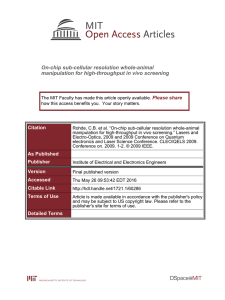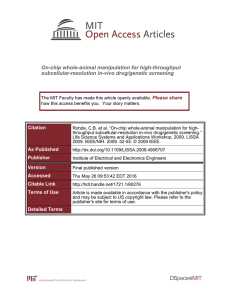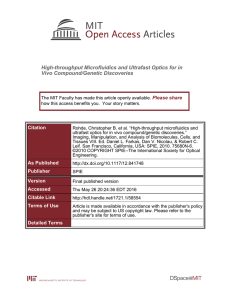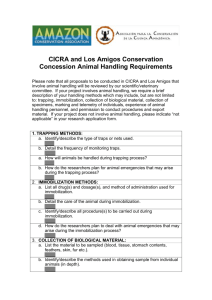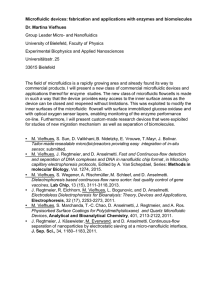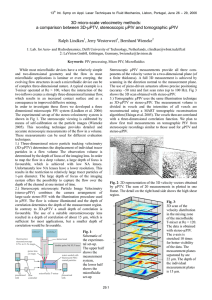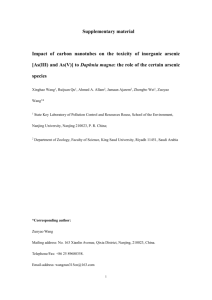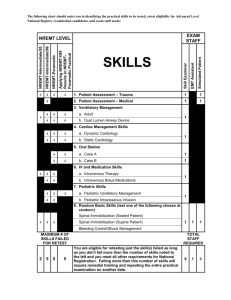High-throughput on-chip in vivo neural regeneration studies usingfemtosecond laser nano-surgery and microfluidics
advertisement
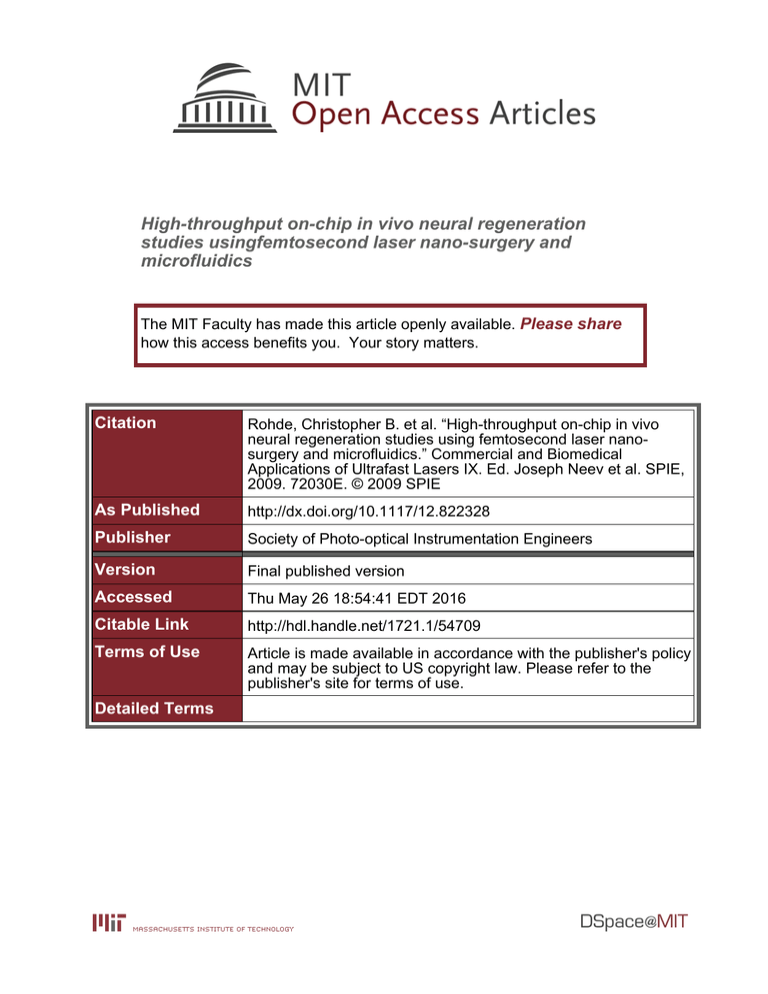
High-throughput on-chip in vivo neural regeneration studies usingfemtosecond laser nano-surgery and microfluidics The MIT Faculty has made this article openly available. Please share how this access benefits you. Your story matters. Citation Rohde, Christopher B. et al. “High-throughput on-chip in vivo neural regeneration studies using femtosecond laser nanosurgery and microfluidics.” Commercial and Biomedical Applications of Ultrafast Lasers IX. Ed. Joseph Neev et al. SPIE, 2009. 72030E. © 2009 SPIE As Published http://dx.doi.org/10.1117/12.822328 Publisher Society of Photo-optical Instrumentation Engineers Version Final published version Accessed Thu May 26 18:54:41 EDT 2016 Citable Link http://hdl.handle.net/1721.1/54709 Terms of Use Article is made available in accordance with the publisher's policy and may be subject to US copyright law. Please refer to the publisher's site for terms of use. Detailed Terms Invited Paper High-throughput on-chip in vivo neural regeneration studies using femtosecond laser nano-surgery and microfluidics Christopher B. Rohde, Fei Zeng, Cody Gilleland, Chrysanthi Samara, Mehmet F. Yanik* Massachusetts Institute of Technology, Cambridge, MA, USA 02139 ABSTRACT In recent years, the advantages of using small invertebrate animals as model systems for human disease have become increasingly apparent and have resulted in three Nobel Prizes in medicine or chemistry during the last six years for studies conducted on the nematode Caenorhabditis elegans (C. elegans). The availability of a wide array of speciesspecific genetic techniques, along with the transparency of the worm and its ability to grow in minute volumes make C. elegans an extremely powerful model organism. We present a suite of technologies for complex high-throughput wholeanimal genetic and drug screens. We demonstrate a high-speed microfluidic sorter that can isolate and immobilize C. elegans in a well-defined geometry, an integrated chip containing individually addressable screening chambers for incubation and exposure of individual animals to biochemical compounds, and a device for delivery of compound libraries in standard multiwell plates to microfluidic devices. The immobilization stability obtained by these devices is comparable to that of chemical anesthesia and the immobilization process does not affect lifespan, progeny production, or other aspects of animal health. The high-stability enables the use of a variety of key optical techniques. We use this to demonstrate femtosecond-laser nanosurgery and three-dimensional multiphoton microscopy. Used alone or in various combinations these devices facilitate a variety of high-throughput assays using whole animals, including mutagenesis and RNAi and drug screens at subcellular resolution, as well as high-throughput high-precision manipulations such as femtosecond-laser nanosurgery for large-scale in vivo neural degeneration and regeneration studies. 1. INTRODUCTION Small animal models have become increasingly important for biological discovery. Notably, studies involving the nematode Caenorhabditis elegans (C. elegans) have contributed significantly to three Nobel Prizes awarded in medicine or chemistry over the last six years. C. elegans has emerged as a powerful model organism due to the availability of a wide array of species-specific genetic techniques, along with its short development time and ability to grow in minute volumes. Additionally, C. elegans is optically transparent, which allows the use of powerful optical techniques that enable precise cellular and subcellular visualization within the living animal. Conventionally, researchers manipulate C. elegans manually using small glass and metal picks and anesthetize the animals prior to high-resolution imaging. However, such manual manipulation is too slow and error prone for highthroughput genetic and drug studies, and the anesthesia is slow to take effect and can have unexpected side effects. Anesthesia is also unsuitable for investigations requiring physiologically active animals, such as studies examining neurophysiology, germ-line proliferation, or development. Thus, a method for precisely manipulating and immobilizing physiologically active animals, with high throughput and minimal physiological effects, is of great importance. We previously demonstrated the first high-throughput, on-chip small-animal screening technology to be performed at cellular resolution [1]. We have since developed techniques that immobilize physiologically active animals with stability comparable to chemical [2]. These devices can be used in various configurations to perform both forward and reverse genetic screens as well as compound screens. * yanik@mit.edu; phone 1 617 253-1583; fax 1 617 258-5846; www.rle.mit.edu/bbng/ Commercial and Biomedical Applications of Ultrafast Lasers IX, edited by Joseph Neev, Stefan Nolte, Alexander Heisterkamp, Rick P. Trebino, Proc. of SPIE Vol. 7203, 72030E © 2009 SPIE · CCC code: 0277-786X/09/$18 · doi: 10.1117/12.822328 Proc. of SPIE Vol. 7203 72030E-1 Downloaded from SPIE Digital Library on 19 Mar 2010 to 18.51.1.125. Terms of Use: http://spiedl.org/terms 2. HIGH-THROUGHPUT SCREENING DEVICES Our devices consist of multiple thin layers of poly(dimethyl siloxane) (PDMS) fabricated by soft lithography [3]. Two or three different layers are used to construct these devices: flow, control, and, when applicable, immobilization. The flow layers contain microchannels for manipulating C. elegans, for immobilizing them for imaging, and for delivering media and reagents. The flow layers also contain microchambers for incubating the animals. The control layers typically lie below the flow channels and consist of microchannels that, when pressurized, flex a membrane into the flow channels, blocking or redirecting the flow [4]. Animals in the flow lines can be imaged through a transparent glass substrate using high-resolution microscopy. The immobilization layer is above the flow layer, and contains channels that are pressurized in the same manner as the control layer. 2.1 On-Chip High-Throughput Sorting Sorters enable rapid selection of organisms with phenotypes of interest for a variety of assays, including genetic and drug screens, and also for reducing phenotypic variability in large-scale assays. Existing small-animal sorters, such as the BIOSORT/COPAS machine, use a flow-through technique similar to the fluorescence-activated cell sorter (FACS) technology. These systems can capture and analyze only one-dimensional intensity profiles of the animals being sorted, and as a result, three-dimensional cellular and subcellular features cannot be resolved [5]. To address this problem and to achieve on-chip integration we have developed the animal sorter shown in Fig. 1. This consists of control channels and valves (gray) that direct worms in the flow channels. Animals enter through inlet valve A. The single suction port C isolates an individual animal from a group (red line), and then any animals remaining in the chamber are washed away by closing valve A and opening valves B and E (blue line). This eliminates the possibility of capturing multiple animals, and allows animals to be screened at a high density. Once the animal is isolated, all valves are closed and the animal is transferred to the multiple aspiration ports on the lower side of the chamber by opening valve D. Here the animal is immobilized in a linear configuration, and optical methods for imaging and manipulation can be used. Following this, the animal can be sent to another device/off chip by opening valve F, or to waste by opening valve E (orange line). The immobilization achieved in our devices can be improve used the method illustrated in Fig. 1b. A channel in the immobilization layer can be rapidly pressurized to expand the thin membrane downwards into the flow channel, as in microfluidic valves [6]. The membrane flexes on top of the captured animals, wrapping around them and forming a tight seal which completely constrains their motion in a linear orientation. Although the animals are constrained by the PDMS membrane from the top and bottom, they still have access to liquid media via the multiple aspiration channels on the side. Fig. 1c shows images from each step of the immobilization process. Proc. of SPIE Vol. 7203 72030E-2 Downloaded from SPIE Digital Library on 19 Mar 2010 to 18.51.1.125. Terms of Use: http://spiedl.org/terms b a C U Fig. 1. Microfluidic device for small animal sorting, immobilization and imaging. (a) Principle of operation of small animal sorter (see text). (b) Illustration of improved immobilization process. Pressurizing the top immobilization channel causes membrane to expand downwards, holding animals against multiple aspiration ports. (c) Isolation, immobilization and imaging of an individual animal. (c.v) shows a close-up combination bright-field and fluorescent image of an immobilized animal illustrating green fluorescent protein (gfp)-labeled mechanosensory axons (scale bar i-iv: 250 m, v: 20 m). 2.2 Large-Scale Time-Lapse Assays with Subcellular Resolution To perform high-throughput time-lapse studies on small animals we have designed the microfluidic-chamber device shown in Fig. 2 for worm incubation and for continuous imaging at subcellular resolution. Microfluidic valuves allow individual chambers to be addressed, and the medium in the chambers can be exchanged through the microfluidic channels. This allows for complex screening strategies and precisely timed exposure to biochemicals (e.g., drugs/RNAi). The small channel dimensions also reduce the cost of whole-animal assays by reducing the required volumes of compounds. An array of posts arranged in a semi-circular configuration is used to permit exchange of media keeping animals in the chamber. To image animals, a flow is used to push the animals toward the posts arranged in an arc inside the chambers (Fig. 2b and Fig. 2c), which restrains animals for subcellular imaging and manipulation. Microchamber chips based on this design can be readily scaled for large-scale screening applications because the number of control lines required to independently address n incubation chambers scales only with log(n) [6]. The millimeter scale of the microchambers can allow hundreds of microchambers to be integrated on a single chip. Proc. of SPIE Vol. 7203 72030E-3 Downloaded from SPIE Digital Library on 19 Mar 2010 to 18.51.1.125. Terms of Use: http://spiedl.org/terms Valves a b C d Control lines Microchambers Fig. 2. Multiplexed microfluidic incubation. (a) Device layout illustrating flow and control lines. (b) Illustration of individual chamber addressing. (c) Semi-circular post arrangement allows animal immobilization and imaging. (d) High-resolution image taken through glass substrate (scale bars a-b: 500 m, c: 100 m, d: 25 m). 2.3 Microfluidic Multiwell-Plate Interface Chip for Compound-Library Delivery and Multiplexed Animal Dispensing To simplify the delivery of existing large-scale RNAi and drug libraries, we have also developed a microfluidic interface device (Fig. 3) that connects these microfluidic chambers to large-scale multiwell-format libraries. Minute amounts of individual compounds from standard multiwell plates can be routed to the incubation chambers, and the connection lines can be automatically washed between samplings. The device consists of an array of aspiration tips that can be lowered into the wells of microwell plates. The chip is designed to allow minute amounts of library compounds to be collected from the wells by suction, routed through multiplexed flow lines one at a time, and delivered to the single output of the device. The output of the interface chip can then be connected to our microfluidic chamber device for sequential delivery of compounds to each microchamber. This device, when run in reverse, also functions as a multiplexed animal dispenser. } Control Layer Membrane Flow Layer 'Suction/Dispense _J L Multi-well Plate S Fig. 3. Microfluidic interface chip. Control lines allow addressing of individual wells via suction through pins seated on a multiwell plate. 3. IMMOBILIZATION STABILITY To determine the effectiveness of our microfluidic immobilization technique we performed both quantitative and qualitative analysis of the displacement of immobilized animals. Fig. 4a illustrates an animal’s motion at three different time points following immobilization. Images of the anterior ventral mechanosensory (AVM) cell body and its axon are taken 5 s apart, pseudo-colored red (first time point), green and blue (final time point), and then superimposed. White regions indicate areas overlapping in all three time points. As seen in Fig. 4a, the degree of movement for an animal immobilized in our device is small, even at 50 magnification. To quantify the effectiveness of our microfluidic immobilization versus chemical anesthesia, we tracked the cell bodies of touch neurons labeled with green fluorescent protein (GFP) using a software algorithm. C. elegans has six touch neuron receptors, with three cells detecting anterior touch, located in the anterior mid-body (AVM, and the left and right anterior lateral mechanosensory (ALML and Proc. of SPIE Vol. 7203 72030E-4 Downloaded from SPIE Digital Library on 19 Mar 2010 to 18.51.1.125. Terms of Use: http://spiedl.org/terms ALMR)), and three cells detecting posterior touch, one located in the posterior ventral mid-body (posterior ventral mechanosensory (PVM) and two in the tail (left and right posterior lateral mechanosensory (PLML and PLMR)). We analyzed movies of animals immobilized using our microfluidic immobilization method and the chemical anesthetic sodium azide (NaN3). The results of tracking these cell bodies are shown in Fig. 4b, which shows the histogram of the frame-to-frame displacement of the tracked centroids, and Fig. 4c, which shows their mean drift over time. The movement of the immobilized animals is quite small, and is comparable to their motion even when deeply anesthetized. Despite being completely restrained externally, the animals can still have small internal movements, especially around the pharynx. However, such internal activity does not cause significant displacement of the neurons imaged, and we were able to acquire high-resolution two-photon images even near the pharynx. 0.7 10 mM NaAzide MicrofIuidic immobilization 0.6 0.5 0.4 0.3 j C-' cJ 0.2 0.1 0 0.2 0.6 0.4 0.8 1.0 Frame-to-frame displacement [im/s] 10 mM NaAzide --Microfluidic immobilization 5 6 9 10 Time [s] Fig. 4. Quantitative and qualitative measurements of microfluidic immobilization. (a) Positional stability of a sub-cellular feature during microfluidic immobilization. Three images of the anterior ventral mechnosensory (AVM) neuron, its axon, and the PVM axon are taken at 5 s apart. These images are then colored red (earliest), green, and blue (latest) and overlaid on top of each other, such that white regions indicate the overlap between all three images (scale bar 20 m). Inset shows close-up of outlined area. (b)(c) Comparison of cell body movement during microfluidic immobilization versus deep anesthetic immobilization using 10 mM NaN3. The centroids of the touch neuron cell bodies are tracked using a computer algorithm that analyzes data from movies taken at 20–30 Hz with 50 magnification. 12 microfluidically-immobilized animals and 9 anesthetized animals were tracked. (b) Histogram showing average displacement of cell bodies between frames divided by the time between frames. (c) Line plot showing mean drift of cell bodies over time. 4. LIFESPAN ANALYSIS To check whether our devices affect the health of the animals being screened, we tracked the lifespans and brood sizes of 25 animals that were each immobilized for 1 min using 15 PSI of pressure in the immobilization channel. Note that the pressure applied to the animals by the membrane is not the full 15 PSI, due to the resistance of the membrane to flexing. Proc. of SPIE Vol. 7203 72030E-5 Downloaded from SPIE Digital Library on 19 Mar 2010 to 18.51.1.125. Terms of Use: http://spiedl.org/terms The immobilized population was compared to a control population that was not run through the device. Fig. 5 shows the lifespans of both populations (maintained at 20 C). The mean lifespan of the immobilized population was 17.3 days (s.d. =.05 days) and 16.9 days for the control population (s.d. = 4.0 days). We used the Graphpad Prism software package to perform the log-rank (Mantel-Cox) test. The p-value is 0.8947, which suggests there is no statistically significant difference between the lifespans of the two populations. Both populations also produced normal brood sizes, and were free of axonal blebbing. Percent survival 100 Control Population Immobilized Population 75 50 25 0 0 5 10 15 20 25 30 Day Fig. 5. Lifespans of microfluidically-immobilized and control populations. The immobilized population consisted of 25 worms that were immobilized for one minute each, and the control population consisted of 23 worms that were not run through the device. Both populations were monitored once a day for dead animals, and surviving animals were transferred to a fresh plate. An animal was scored as dead if it did not respond to prodding with a platinum worm pick. The mean lifespan of the immobilized population was 17.3 days (s.d. 5.0 days), and the mean lifespan of the control population was 16.9 days (s.d. 4.0 days). 5. APPLICATIONS The high immobilization stability achieved in our devices enables the use of a number of key optical techniques. To illustrate this we have chosen two methods that require repeatable, highly stable immobilization: multi-photon microscopy and femtosecond-laser nanosurgery. Multi-photon microscopy, including two-photon excitation fluorescence (TPEF) [7], is an important application that requires a very high degree of stabilization. Multi-photon microscopy is inherently non-linear, and thus has the ability to perform optical sectioning with negligible out-of-plane absorption and emission. This dramatically reduces photobleaching and phototoxicity [8]. This is especially significant in assays that require animals to be imaged at multiple time points. The advantages of multi-photon microscopy are offset by the requirement for live animals to be anesthetized, due to the long duration needed to capture an image. We have used our immobilization method to successfully acquire two-photon images of non-anesthetized live animals using devices bonded to 175 m-thin glass slide. The middle image of Fig. 6 shows a volume reconstructions of a pmec4::gfp animal, obtained by a two-photon microscope scanning at 0.2 frames s1 using a 40/0.8 NA water-immersion objective. In this configuration, imaging a 120 m 120 m 30 m volume required roughly two minutes of stable immobilization. Such non-invasive imaging of non-anesthetized animals can allow investigation of cellular processes sensitive to anesthesia, such as neural degeneration, regeneration and embryogenesis. Femtosecond-laser micro/nanosurgery enables precision ablation of sub-cellular processes with minimal collateral damage [9]. We have previously employed this technique to perform the first axonal regeneration study in C. elegans [10][11], which opened up tremendous potential for genetic/drug discoveries on neural degeneration and regeneration using a genetically amenable whole-animal model. However, manually preparing an animal for surgery, imaging and Proc. of SPIE Vol. 7203 72030E-6 Downloaded from SPIE Digital Library on 19 Mar 2010 to 18.51.1.125. Terms of Use: http://spiedl.org/terms recovering it afterwards are fairly laborious tasks, and the ability to rapidly immobilize animals in a repeatable fashion can greatly accelerate investigations into neural degeneration and regeneration. Furthermore, the effects of long-term anesthesia on these processes are not known. Using our immobilization technique, we can immobilize animals and perform femtosecond-laser nanosurgery repeatably, rapidly and with sub-cellular precision. The rightmost image of Fig. 6 shows a pmec4::gfp animal whose touch neuron process has been cut. Our on-chip femtosecond-laser nanosurgery technique is a powerful tool for the discovery of potential drugs and genetic factors affecting neural degeneration and regeneration. On-chip animal manipulation On-chip 3d two-photon imaging Femtosecond laser nano-surgery Fig. 6. Microfluidic immobilization enables several key applications in live, un-anesthetized animals. Middle image shows volume reconstruction of images captured using two-photon microscopy. Posterior midbody of mec4::gfp animal and PVM neuron PVM are shown. Right image shows successful axotomy of AVM process. 20 nJ femtosecond pulses were delivered using a Mai Tai Ti:Sapphire laser (Spectra-Physics) at a rate of 80 MHz to successfully cut the axons. 6. SCREENING STRATEGIES Combining the devices we have developed in different configurations can enable a wide variety of assays. Fig. 7 shows a setup to perform large-scale RNAi and drug screens with time-lapse imaging by combining our sorter, integrated microchambers, and multiwell plate interface chips. Although C. elegans is self-fertilizing and has perhaps the lowest phenotypic variability among multicellular model organisms [12], variations among assayed animals are still present, reducing the robustness of current large-scale screens. Sorting technology can be used to select animals with similar phenotypes (such as fluorescent marker expression levels) before large-scale assays to significantly reduce initial phenotypic variations [12][13]. Feature extraction algorithms can be run on animals immobilized in the sorter or the incubation chambers to screen thousands of animals on a single chip. Proc. of SPIE Vol. 7203 72030E-7 Downloaded from SPIE Digital Library on 19 Mar 2010 to 18.51.1.125. Terms of Use: http://spiedl.org/terms sorter chambers Imaging/surgery nulti-well interface RNA1/drug library Fig. 7. Experimental arrangement for RNAi/drug screening. 7. CONCLUSIONS We have reported on key integrated high-throughput technologies that enable high-throughput sub-cellular small animal studies. In various configurations, these technologies have the potential to significantly accelerate current genetic and drug screens and also enable completely new types of whole-animal assays. The microfluidic immobilization method present in our small animal sorter is a rapid and highly repeatable technique for immobilizing small animals for imaging and manipulation of sub-cellular processes without anesthesia. We have used this to demonstrate multiphoton microscopy and femtosecond-laser nanosurgery on physiologically active animals. When combined with the multiplexed incubation chambers and microfluidic interface devices we have developed, these technologies have the potential not only to significantly accelerate current whole-animal genetic and drug screens but also to enable completely new types of assays at sub-cellular. We are currently using these devices to investigate the genetic and chemical mechanisms involved in neural regeneration. REFERENCES [1] [2] [3] [4] [5] [6] [7] Rohde, C. B., Zeng, F., Gonzalez-Rubio, R., Angel, M. and Yanik, M. F., “Microfluidic system for on-chip highthroughput whole-animal sorting and screening at subcellular resolution,” Proc. Natl. Acad. Sci. U. S. A. 104, 13891–13895 (2007). Zeng, F., Rohde, C. B. and Yanik, M.F., “Sub-cellular precision on-chip small-animal immobilization, multi-photon imaging and femtosecond laser manipulation,” Lab Chip 8, 653–656 (2008). Xia, Y. and Whitesides, G., “Soft Lithography,” Annu. Rev. Mater. Sci. 28, 153–184 (1998). Unger, M. A., Chou, H. P., Thorsen T., Scherer, A. and Quake, S.R., “Monolithic Microfabricated Valves and Pumps by Multilayer Soft Lithography,” Science 288, 113–116 (2000). Dupuy D., Hidalgo C.A., Venkatesan K., Tu D., Lee D., Rosenberg J., Svrzikapa N., Blanc A., Carnec A., et. al., “Genome-scale analysis of in vivo spatiotemporal promoter activity in Caenorhabditis elegans,” Nat Biotechnol 25, 663-668 (2007). Melin, J. and Quake, S., “Microfluidic Large-Scale Integration: The Evolution of Design Rules for Biological Automation,” Annu Rev Biophys Biomol Struct 36, 213–231 (2007). Denk W., Strickler, J. H. and Webb, W.W., “Two-photon laser scanning fluorescence microscopy,” Science 248, 73–76 (2000). Proc. of SPIE Vol. 7203 72030E-8 Downloaded from SPIE Digital Library on 19 Mar 2010 to 18.51.1.125. Terms of Use: http://spiedl.org/terms [8] [9] [10] [11] [12] [13] Filippidis, G., Kouloumentas. C., Voglis. G., Zacharopoulou. F., Papazoglou, T.G. and Tavernarakis, N., “Imaging of Caenorhabditis elegans neurons by Second Harmonic Generation and Two-Photon Excitation Fluorescence,” J. Biomed. Opt. 10, 024015 (2005). Vogel A., Noack, J., Huttman, G. and Paltauf, G., “Mechanisms of femtosecond laser nanosurgery of cells and tissues,” Appl. Phys. B: Lasers Opt. 81, 1015–1047 (2005). Yanik, M. F., Cinar, H., Cinar, H. N., Chisholm, A. D., Jin Y. and Ben-Yakar A., “Nerve Regeneration in C. elegans after femtosecond laser axotomy,” Nature 432, 822 (2004). Yanik, M. F., Cinar, H., Cinar, H. N., Gibby, A., Chisholm, A. D., Jin, Y. and Ben-Yakar, A., “Neurosurgery: Functional Regeneration after Laser Axotomy,” IEEE J. Sel. Top. Quantum Electron. 12, 1283–1290 (2006). Kaletta, T., Butler, L., and Bogaert, T., [Model Organisms in Drug Discovery], Wiley, West Sussex, UK (1997). Zhang J. H., Chung T.D., and Oldenburg K.R., “A Simple Statistical Parameter for Use in Evaluation and Validation of High Throughput Screening Assays.” J Biomol Screen 4, 67–73 (1999). Proc. of SPIE Vol. 7203 72030E-9 Downloaded from SPIE Digital Library on 19 Mar 2010 to 18.51.1.125. Terms of Use: http://spiedl.org/terms
